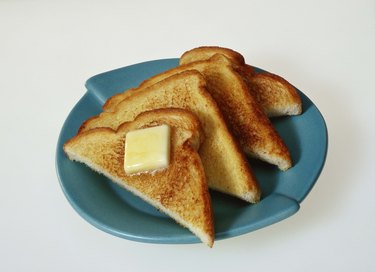
A reducing sugar is a chemical term for a sugar that acts as a reducing agent and can donate electrons to another molecule. Specifically, a reducing sugar is a type of carbohydrate or natural sugar that contains a free aldehyde or ketone group. Reducing sugars can react with other parts of the food, like amino acids, to change the color or taste of the food.
Different Types of Sugars
Video of the Day
Sugars are found naturally in all fruits, vegetables, dairy products and whole grains. These natural sugars are otherwise known as carbohydrates, an essential macronutrient. Dietary carbohydrates are categorized as monosaccharides, which are single sugar molecules; disaccharides -- two sugar molecules linked together; or oligosaccharides and polysaccharides, which are longer chains of sugar molecules. Monosaccharides include glucose, galactose and fructose, which are all reducing sugars. Monosaccharides are not often found alone in nature, but they are components of disaccharides and polysaccharides. For this reason, some disaccharides, such as maltose, are also reducing sugars.
Video of the Day
Examples of Reducing Sugars
The most important monosaccharide and reducing sugar is glucose. In the body, glucose is known as blood sugar because it is essential for brain function and physical energy. Fructose is another reducing sugar and is known as the sweetest of all monosaccharides. Galactose, another reducing sugar, is a component of lactose that is found in dairy products. Maltose is not often found in nature, but it is produced during digestion when starch molecules are broken down.
The Maillard Reaction
The Maillard reaction is a process that occurs when a reducing sugar reacts with an amine, resulting in the browning of food. This reaction usually occurs when food is heated or left at room temperature for a long period of time. The browning process is evident on the crust of bread or the skin of a roasted turkey. The Maillard reaction also contributes to the flavor and aroma of many food items, such as coffee, chocolate and baked breads.
Nonreducing Sugars
Some disaccharides, such as sucrose, are nonreducing sugars, meaning they cannot donate electrons to other molecules. Sucrose consists of the two reducing sugars, glucose and fructose, and contains no free carbonyl groups. Sucrose occurs naturally in many foods and is often added to many processed foods to contribute sweetness.
- Food Science, Fifth Edition; Norman N. Potter and Joseph H. Hotchkiss
- Krause's Food & The Nutrition Care Process; L. Kathleen Mahan et al.
- Essentials AS Biology for OCR; Glenn Toole and Susan Toole
- Introduction to Food Chemistry; Richard Owusu-Apenten
- The Maillard Reaction; S.E. Fayle and Juliet A. Gerrard
- Biology Insights; Caroline Koh